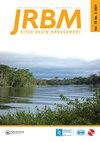哈拉玛亚湖崩塌的驱动因素及综合修复策略
IF 1.9
Q3 WATER RESOURCES
International Journal of River Basin Management
Pub Date : 2022-03-03
DOI:10.1080/15715124.2022.2047709
引用次数: 1
摘要
在世界许多地区,湖泊生态系统正面临着萎缩的威胁,埃塞俄比亚也是如此。埃塞俄比亚的高原湖泊之一哈拉马亚湖在十年前的2004年就已经干涸了。本研究在埃塞俄比亚东哈拉日的哈拉玛亚湖流域进行,目的是确定哈拉玛亚湖干涸的驱动因素并提出恢复策略。为了达到预定的目标,采用了各种方法。驱动因素是通过研究50年来陆地卫星图像的三角测量数据、气候变化趋势、焦点小组讨论和回顾以往的研究成果来确定的。为了了解土地利用动态对湖泊环境的影响,检测了主要的土地利用变化类型,并对流域进行了变化分析。为探讨气候变化与湖泊环境的关系,采用降雨指数法对原玛雅气象站30年的年降水量分布进行了评价。研究结果表明,聚落用地、气候变化和流域内外湖泊过度开发是主要驱动因素。为了提出湖泊恢复战略,本研究采用了联合国人类和生物圈保护区。研究将流域划分为核心区、缓冲区和过渡带三类。1985年确定湖的大小为核心区,核心区周围100米为缓冲区。研究结果建议保护核心区,引进苹果类水果,以禁止人类在缓冲地带定居。此外,本研究建议在过渡区内进行的所有活动都应符合可持续发展目标战略。因此,强烈建议在未来的哈拉玛亚湖及其流域恢复战略中采用本研究的成果和提出的策略。本文章由计算机程序翻译,如有差异,请以英文原文为准。
The drivers for the collapse of Lake Haramaya and proposed integrated rehabilitation strategies
ABSTRACT Lake ecosystem is facing a threat of shrink in many parts of the world and the same in Ethiopia. Lake Haramaya, one of the highland lakes in Ethiopia, has been dried a decade ago in 2004. This study was conducted in Lake Haramaya watershed, Eastern Hararge, Ethiopia, with the objectives of identifying drivers of dried Lake Haramaya and proposing rehabilitation strategies. Various methodologies were employed to meet the intended objectives. Drivers are identified by the study of triangulated data from landsat images of five decades, trend of climate change, focus group discussions, and review of previous research results. To see the effect of land use dynamics on the lake environment, major LULC types were detected and the change analysis of the watershed was executed. To investigate association between climate change and lake environment, the rainfall index method was employed to evaluate 30 years annual rainfall distribution of Haramaya meteorological stations. The results of this method reveal that land use for settlement, climate change, and overexploitation of the lake within and out of the watershed were primary drivers. To propose lake rehabilitation strategies, the study employed the United Nation man and biosphere protection zones. The study classified the watershed into three classes as core, buffer, and transition zones. The size of the lake in 1985 was decided as the core area and 100 metre surrounding the core area as the buffer zone. The result of the study proposed protection of the core area and introduction of apple fruits replacing chat in the buffer zone with prohibition of human settlement. In addition, this study suggests that all activities that take place in the transition zone should comply with sustainable development goal strategies. Therefore, it is highly recommended to adopt the output and proposed strategies of this study in future rehabilitation strategies of Lake Haramaya and its watershed.
求助全文
通过发布文献求助,成功后即可免费获取论文全文。
去求助
来源期刊

International Journal of River Basin Management
WATER RESOURCES-
CiteScore
6.00
自引率
4.00%
发文量
48
期刊介绍:
include, but are not limited to new developments or applications in the following areas: AREAS OF INTEREST - integrated water resources management - watershed land use planning and management - spatial planning and management of floodplains - flood forecasting and flood risk management - drought forecasting and drought management - floodplain, river and estuarine restoration - climate change impact prediction and planning of remedial measures - management of mountain rivers - water quality management including non point source pollution - operation strategies for engineered river systems - maintenance strategies for river systems and for structures - project-affected-people and stakeholder participation - conservation of natural and cultural heritage
 求助内容:
求助内容: 应助结果提醒方式:
应助结果提醒方式:


